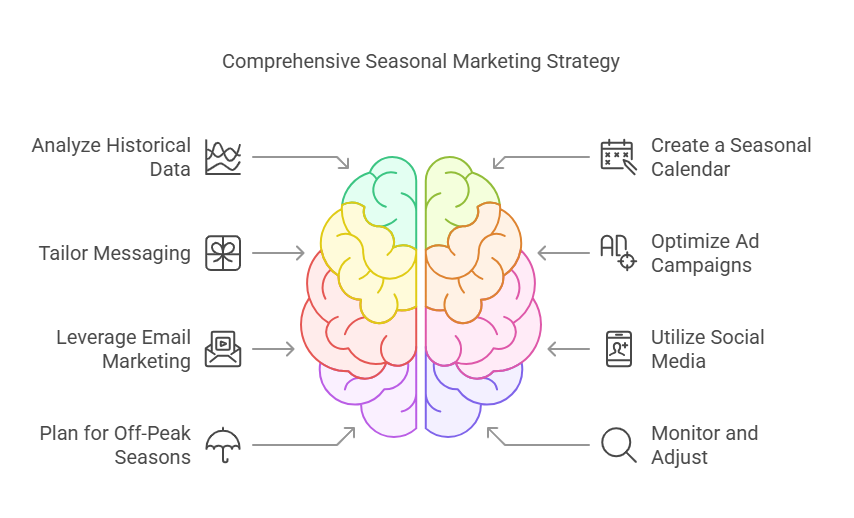In the world of performance marketing, understanding seasonality is crucial for maximizing campaign effectiveness and driving consistent results. Seasonal trends can significantly influence consumer behavior, purchasing patterns, and overall marketing performance. By recognizing these fluctuations and adapting strategies accordingly, businesses can achieve year-round success. In this blog post, we will explore the impact of seasonality on performance marketing and provide actionable strategies to navigate seasonal changes effectively.
Understanding Seasonality in Performance Marketing
Seasonality refers to the predictable fluctuations in consumer demand and behavior that occur at specific times of the year. These changes can be driven by various factors, including holidays, weather changes, cultural events, and economic conditions. For example, retail businesses often see spikes in sales during the holiday season, while travel companies may experience increased demand during summer months.
The Importance of Recognizing Seasonal Trends
- Consumer Behavior: Understanding seasonal trends helps marketers anticipate changes in consumer preferences and purchasing behavior. This knowledge allows businesses to tailor their messaging and offers to align with consumer needs.
- Budget Allocation: Recognizing peak seasons enables marketers to allocate budgets more effectively. By investing more during high-demand periods, businesses can maximize their return on investment (ROI).
- Campaign Timing: Timing is critical in performance marketing. By launching campaigns at the right moment, businesses can capitalize on increased consumer interest and drive higher engagement and conversions.
- Competitive Advantage: Companies that effectively leverage seasonal trends can gain a competitive edge. By being proactive and responsive to changes in the market, businesses can position themselves as leaders in their industry.
Strategies for Year-Round Success

1. Analyze Historical Data
Start by analyzing historical data to identify seasonal trends specific to your industry. Look for patterns in consumer behavior, sales spikes, and engagement metrics during different times of the year. This analysis will provide valuable insights for future campaign planning.
2. Create a Seasonal Marketing Calendar
Develop a seasonal marketing calendar that outlines key dates, holidays, and events relevant to your business. This calendar should include important sales periods, promotional events, and content themes. By planning ahead, you can ensure that your marketing efforts align with consumer expectations.
3. Tailor Messaging and Offers
Customize your messaging and offers to resonate with seasonal themes. For example, during the holiday season, focus on gift-giving and festive promotions. In the summer, highlight outdoor activities and travel-related products. Tailoring your messaging helps create a more relevant and engaging experience for consumers.
4. Optimize Ad Campaigns
Adjust your ad campaigns based on seasonal trends. Use seasonal keywords, visuals, and calls-to-action that align with the time of year. For instance, during back-to-school season, emphasize school supplies and educational products. Regularly monitor campaign performance and make adjustments as needed.
5. Leverage Email Marketing
Email marketing is an effective way to communicate seasonal promotions and updates. Segment your email list based on customer behavior and preferences, and send targeted campaigns that highlight seasonal offers. Use compelling subject lines and engaging content to capture attention and drive conversions.
6. Utilize Social Media
Social media platforms are ideal for promoting seasonal campaigns and engaging with your audience. Create seasonal content that encourages interaction, such as contests, polls, or user-generated content. Use relevant hashtags to increase visibility and reach a broader audience.
7. Plan for Off-Peak Seasons
Don’t overlook off-peak seasons. Use this time to focus on brand awareness, customer engagement, and relationship building. Consider running promotions or campaigns that encourage customers to engage with your brand even when demand is lower. This approach can help maintain momentum and keep your brand top-of-mind.
8. Monitor and Adjust
Continuously monitor the performance of your seasonal campaigns. Use analytics tools to track key metrics such as engagement, conversion rates, and ROI. Be prepared to adjust your strategies based on real-time data and consumer feedback to optimize results.
Conclusion
Understanding the impact of seasonality on performance marketing is essential for achieving year-round success. By analyzing historical data, creating a seasonal marketing calendar, tailoring messaging, and optimizing campaigns, businesses can effectively navigate seasonal fluctuations and capitalize on consumer demand. With proactive planning and a data-driven approach, organizations can enhance their marketing efforts, drive engagement, and ultimately boost sales throughout the year. Embrace the power of seasonality in your performance marketing strategy and watch your business thrive in every season.
Enhance your skills with a Advanced Performance Marketing Course to implement seasonal strategies and boost engagement. Embrace seasonality and watch your business thrive!